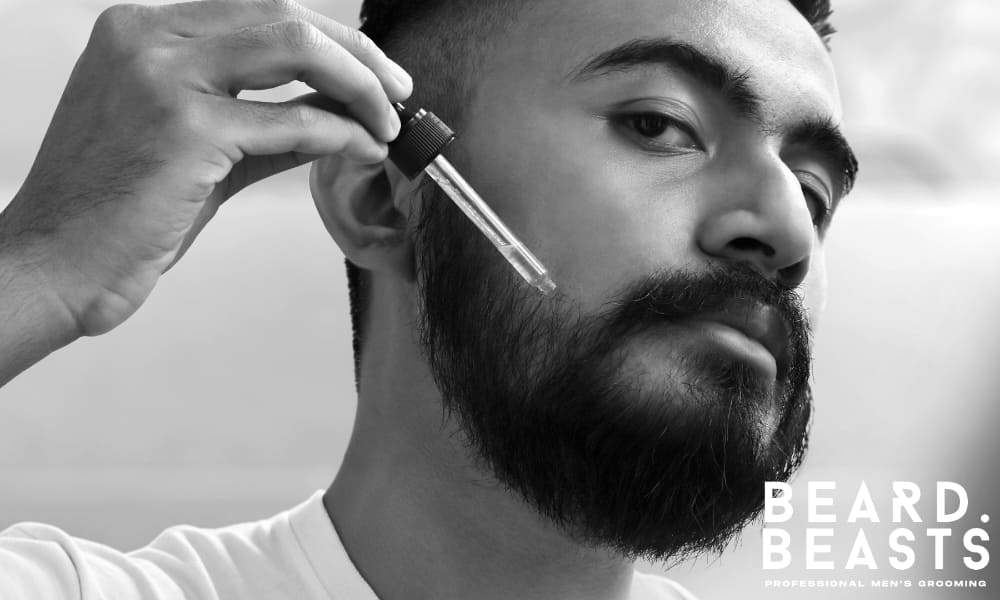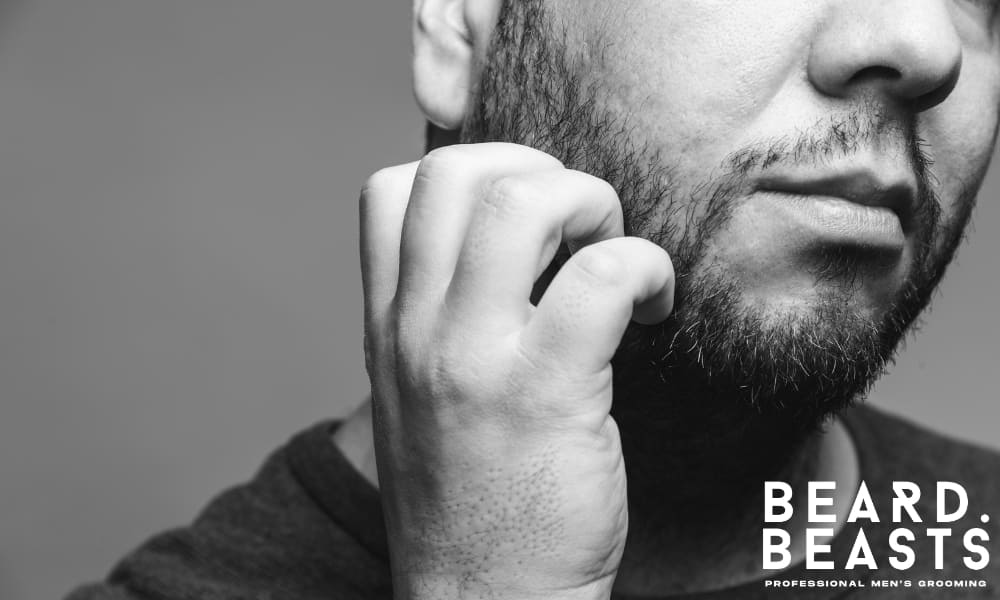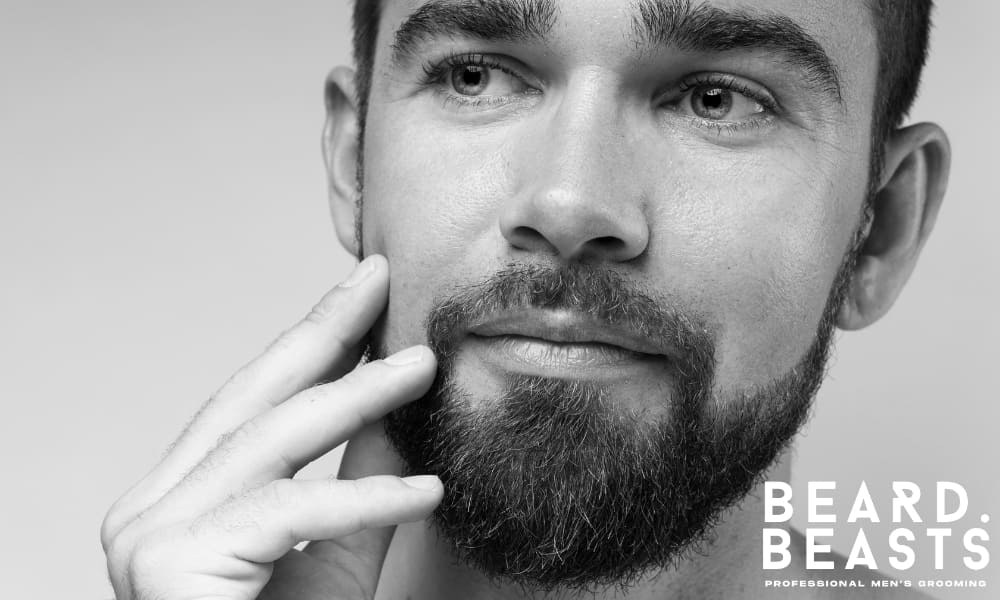Dry skin beneath your beard can make even the thickest facial hair look dull, flaky, and unkempt. It’s more than discomfort—it’s a clear sign your grooming routine isn’t supporting the skin that anchors your beard.
Left unaddressed, dryness leads to itchiness, irritation, and a beard that loses structure and appeal. But with the right approach, you can restore comfort, improve texture, and protect the skin long-term.
This guide breaks down what causes dry skin under a beard—and how to fix it fast using expert-backed solutions. Whether you’re dealing with seasonal itch or persistent dryness, here’s how to regain control and elevate your grooming routine.
What Causes Dry Skin Under Your Beard?

Understanding what’s drying out the skin beneath your beard is the first step to fixing it.
These are the most common culprits men face—most of which can be addressed with simple grooming upgrades.
Lack of Proper Hydration
When your skin lacks moisture, it starts to flake, tighten, and itch—especially beneath dense facial hair. Dehydrated skin struggles to maintain balance, making your beard look rough and feel uncomfortable.
Harsh Beard Products
Many cleansers and budget beard products contain alcohols or sulfates that strip away natural oils. Without that protective layer, your skin dries out fast and starts reacting with redness or irritation.
Overwashing or Hot Water
Washing your beard too often—or with hot water—can disrupt the skin’s barrier. This removes essential oils and leaves the area beneath your beard more vulnerable to dryness and inflammation.
Cold Weather or Dry Air
Exposure to winter air, indoor heating, or low-humidity environments pulls moisture from your skin. Beards can trap dryness underneath, making it harder to notice until flakes or discomfort appear.
Underlying Skin Conditions
If dryness is severe, persistent, or comes with redness and scaling, it may be more than poor grooming. Conditions like eczema or seborrheic dermatitis often mimic common beard dryness but require targeted care.
Identifying the cause gives you the leverage to fix it—because solving dry skin under your beard starts with knowing what’s behind it.
How to Treat Dry Skin Under Your Beard—Step-by-Step

A flaky, irritated beard isn’t a minor inconvenience—it’s a breakdown in skin health. These steps are designed to restore your skin barrier, support beard growth, and deliver lasting hydration where it matters most.
Stop Using Hair Shampoo on Your Beard
Shampoo is formulated for scalp hair, not facial skin—which is thinner, more sensitive, and easily stripped. Replace it with a pH-balanced beard wash that removes buildup while preserving the skin’s natural oils.
Exfoliate the Skin Beneath Your Beard Twice a Week
Flaking is often caused by trapped dead skin cells that block hydration and clog follicles. A soft-bristle beard brush or chemical exfoliant clears debris, improves circulation, and prepares the skin to absorb moisture more effectively.
Apply Beard Oil Immediately After Cleansing
Post-wash, your pores are open and ready to retain hydration—timing your oil here maximizes its impact. Use a beard oil containing fast-absorbing emollients like jojoba or argan to mimic sebum and nourish the skin directly.
Layer on Beard Balm to Seal in Moisture and Strengthen Protection
Beard balm acts as a conditioning barrier that locks in hydration and shields the skin from cold, dry air. It’s especially effective for medium to long beards where moisture retention becomes harder at the skin level.
Avoid Hot Water—Use Lukewarm Instead
Hot water depletes the lipid layer that protects your skin and beard, causing rapid moisture loss. Lukewarm water cleans without over-stripping, giving your routine a critical edge in skin preservation.
This routine isn’t cosmetic—it’s corrective. Follow it with consistency, and you’ll repair moisture balance, restore skin health, and eliminate dryness at the root.
When Dry Skin Under Beard Means Something More

Not all dryness is caused by routine mistakes—sometimes, the problem runs deeper. If your skin remains irritated despite a structured grooming regimen, it may point to an underlying condition.
Persistent Flaking or Redness
If flakes reappear daily no matter how well you moisturize, it’s likely not just dry skin. Chronic inflammation may indicate seborrheic dermatitis, which often mimics beard dandruff but requires medicated treatment.
Itching That Doesn’t Respond to Products
When high-quality oils and balms fail to calm irritation, the issue may be internal. Skin conditions like eczema or psoriasis often flare beneath facial hair and need targeted dermatological care.
Burning, Cracking, or Soreness
These symptoms go beyond dryness and signal a compromised skin barrier. Left untreated, they can worsen with exposure to products, water, or shaving—making professional evaluation essential.
Thick Scaling or Discoloration
If the skin under your beard shows thickened patches, discoloration, or scaly buildup, don’t ignore it. These signs often point to fungal infections or chronic skin disorders that won’t improve with over-the-counter products.
When dryness resists proper grooming, it’s time to stop guessing and consult a dermatologist—because healthy skin is the foundation of a strong beard.
Beard Care Products to Help You Fix Dry Skin Fast
Dry skin under your beard isn’t just about what you do—it’s about what you use. The right products support the skin barrier, deliver real hydration, and prevent future flare-ups.
Beard Wash for Dry Skin
Look for a beard wash that’s sulfate-free, pH-balanced, and designed specifically for sensitive skin. It should cleanse without stripping away natural oils or leaving your face tight and dry.
Moisturizing Beard Oil
Choose an oil blend rich in jojoba, argan, and vitamin E to hydrate both hair and skin. A fast-absorbing oil replenishes moisture daily and restores comfort to dry, irritated areas.
Conditioning Beard Balm
Beard balm reinforces moisture retention while offering soft hold and protection. It’s especially useful in cold climates or during seasonal changes when skin stress is at its peak.
Soft-Bristle Beard Brush
A quality beard brush does more than shape—it exfoliates gently and lifts debris from the skin’s surface. Brushing daily encourages circulation and improves product absorption at the root level.
Investing in the right beard care products isn’t optional—it’s the difference between a beard that struggles and one that thrives from the skin up.
Once your grooming kit is in place, daily habits will determine whether dryness stays gone or keeps coming back.
Grooming Tips for Preventing Beard Dryness Long-Term
Fixing dry skin is only the beginning—keeping it from coming back requires consistency and smarter grooming habits. These long-term strategies help protect your skin, preserve moisture, and maintain a healthier-looking beard year-round.
Wash Your Beard Two to Three Times per Week Only:
Overwashing strips away natural oils that your skin needs to stay balanced. Cleansing just a few times a week is enough to keep buildup away without drying out the skin beneath.
Apply Beard Oil Every Morning:
Beard oil should be part of your daily routine, especially after washing or showering. It keeps the skin hydrated and prevents the tightness or itching that leads to flaking.
Exfoliate Once or Twice Weekly:
Regular exfoliation clears away dead skin cells and improves product absorption. This helps prevent clogged follicles and keeps the skin beneath your beard breathing freely.
Protect Your Beard in Harsh Weather:
Cold air and dry heat both pull moisture from your skin. Use beard balm as a protective barrier during winter or anytime your environment changes drastically.
Stay Hydrated and Eat Skin-Friendly Nutrients:
Healthy skin starts from within—drink enough water daily and aim for nutrients like omega-3s, zinc, and vitamin E. These support skin regeneration and resilience from the inside out.
Routine creates results—when your grooming habits support your skin consistently, dry patches and beard discomfort become a thing of the past.
Final Thoughts: Solve Dry Skin Under Your Beard at the Source
Dry skin beneath your beard isn’t just a nuisance—it’s a breakdown in skin health that weakens both appearance and performance. Left untreated, it leads to irritation, flaking, and long-term disruption of your beard’s growth environment.
Fortunately, this is a fixable problem. With disciplined care, quality products, and structured habits, you can restore balance, reinforce the skin barrier, and stop dryness at its source.
A strong beard starts where you can’t see it—below the surface. Prioritize your skin, elevate your routine, and build a beard that lasts.





